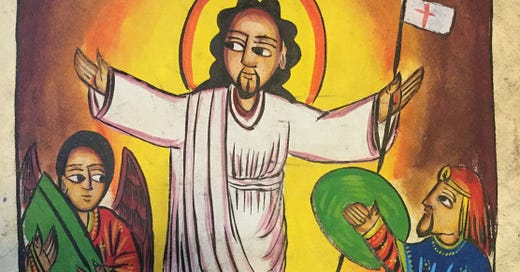According to the Ge’ez Rite, Easter is called tinsa’é and faseeka. The first word is straightforward enough; it means resurrection or being raised from the dead. It refers to Jesus of Nazareth’s being raised from the dead, unlike all the dead raised in the Hebrew Bible and in the New Testament by Jesus himself. One, he was raised by God the Father. Two, he was raised not to die again, but unto power, giving the Apostles (in both the loose and strict sense of this term) forty days more in his direct physical presence before sending the Holy Ghost upon them, and giving all of humanity more and more time, because of his steadfast kindness toward us, till he comes again to judge the quick and the dead.
I have told you before that Ps and Fs are interchangeable, in the Near East. And if I have not, now I have. The Ge’ez faseeka comes from the Old Greek pascha which comes from the Biblical Hebrew and Aramaic pesakh, which means passover. *whew lawd* That’s a metric ton of transliteration, and itself a parable of passing over. During this opportune moment, the fifty paschal days from pesakh to Pentecost, we greet one another with the following call and response:
ክርስቶስ ተንሥአ እምውታን (kristos tensi’a imwtan or imutan or imootan)
በዓቢይ ኃይል ወስልጣን (be’abiy hayl we’silTan)
አሰሮ ለሰይጣን (asero le’seyTan)
አግዓዞ ለአዳም (ag’azo le’adam)
ሰላም (selam)
እምይእዜሰ (im’y’i’zése)
ኮነ (ko’ne)
ፍሥሐ ወሰላም (fsiha we’selam)
christ is risen from the dead,
with great power and authority
he incarcerated satan
and freed adam
peace
from now on
it happened / is happening
joy and peace
But those of us living in the West know and will often settle for the shorter Greek Rite christos anesti, alithos anesti, christ is risen, amen, he is risen. Know when to settle, and when to proclaim our full tradition.
Enjoy the feast!



